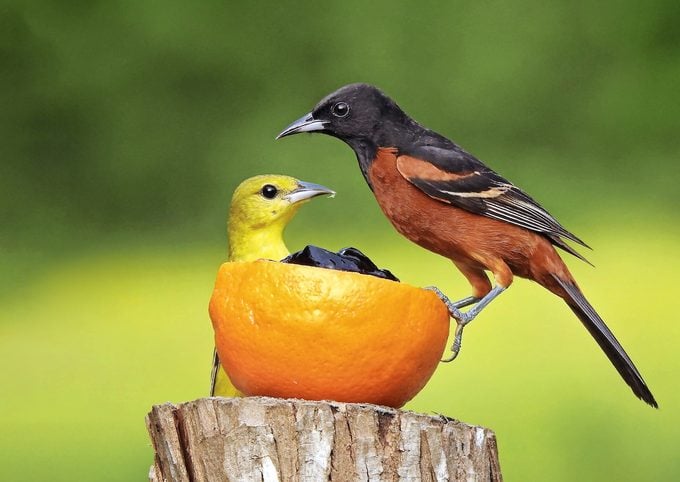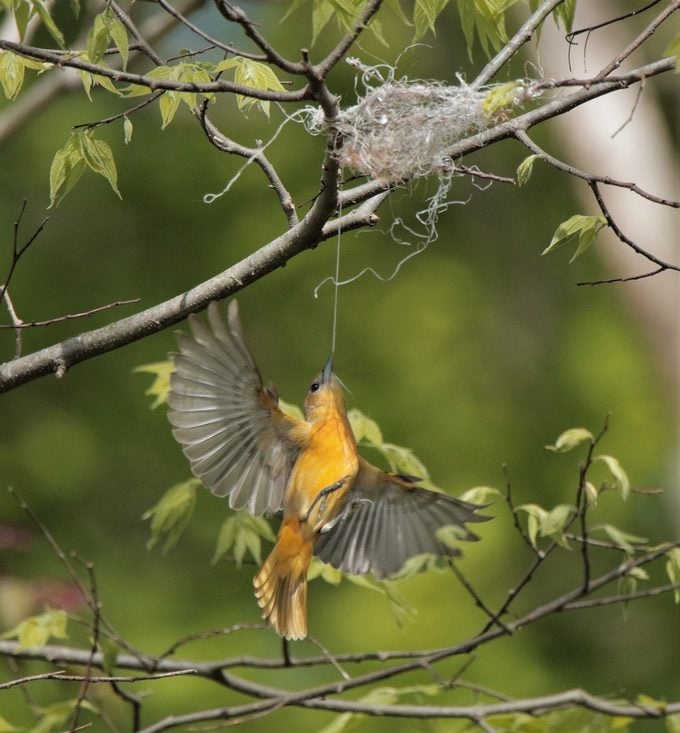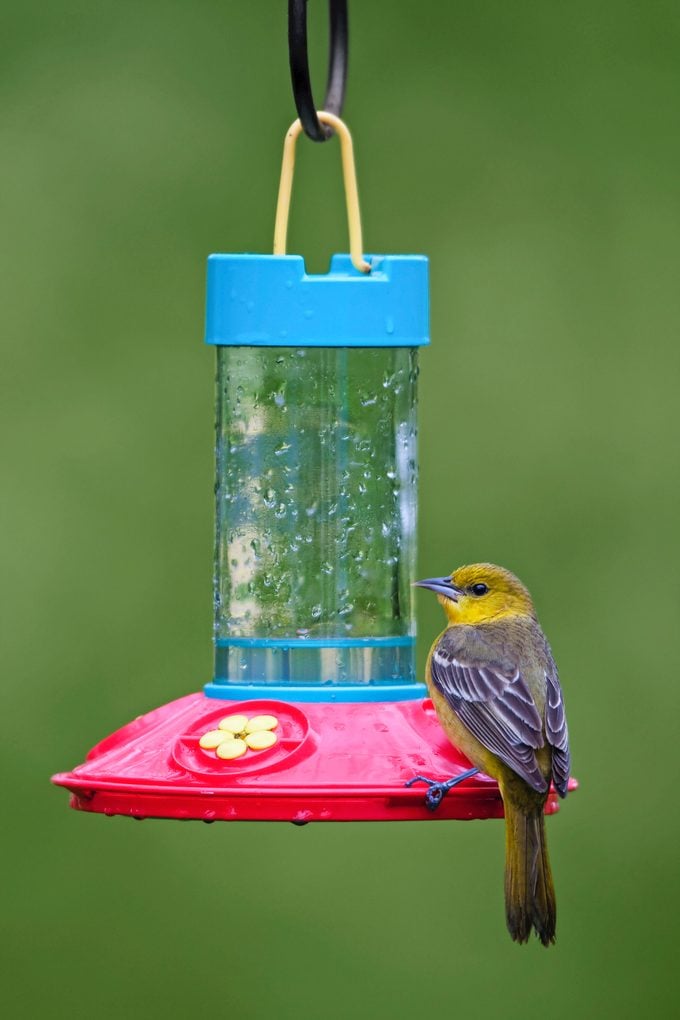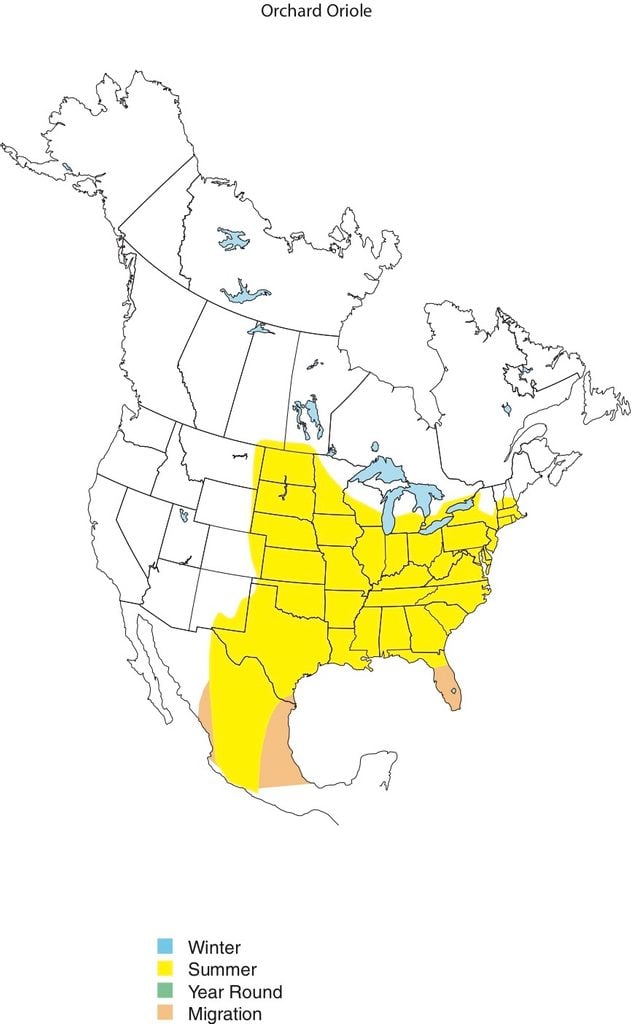How to Identify an Orchard Oriole
Updated: Jul. 12, 2024
Attract a nectar-loving orchard oriole to your yard with fruit. Learn their range, favorite foods, and what the male and females look like.
On This Page
Orchard Oriole vs. Baltimore Oriole

An oriole that’s smaller and much darker than a Baltimore oriole dashes through the flowering trees. The bird you’ve spotted is probably an orchard oriole. The two birds share similar markings, but where a male Baltimore oriole has a bright pop of orange, the orchard oriole sports a darker chestnut color. Male orchard orioles have black head feathers, a burnt orange chest, and a black tail and wings with white accents.
This is the smallest of the eight oriole species found north of Mexico. It has a wingspan of a little more than 9 inches. For comparison, the Baltimore oriole’s wingspan is nearly 12 inches.
Female Orchard Oriole

Female orchard and female Baltimore orioles look alike, too. They share a warm-hued chest, head and tail feathers, but the female Baltimore has touches of tangerine orange while the orchard’s color runs closer to greenish yellow.
Female orchard orioles are the primary nest builders (though their mates may sometimes help), constructing their homes in forks of branches. Over the course of a week, they weave grass and other flexible plant fibers into a pouch or a basket, then line the nests with softer plant down and feathers.
Orchard Oriole Habitat

Unlike some other birds, orchard orioles will share their territory in the summer. In fact, one tree may hold several nesting pairs. They build their homes alongside other bird species, too, such as American robins, eastern kingbirds and the look-alike Baltimore orioles.
Orchard orioles usually prefer open woodlands, lakeshores, parks, farms and, of course, orchards. They spend time in treetops and bushes where they forage for insects and spiders with their sharp, thin beaks.
Learn how to identify a Bullock’s oriole.
What Does an Orchard Oriole Eat?

Early May is the perfect time to attract this species as the hungry migrants travel north. Just like Baltimore orioles, orchards have a sweet tooth and drop by backyards with the right spread of fruit and nectar offerings. They’re even known to stop at sugar-water feeders.
“One great way to attract orioles is by offering orange halves. Just stick the oranges on a nail and enjoy watching the orioles feast,” says Emma Greig, the project leader for Project FeederWatch of the Cornell Lab of Ornithology.
Grape jelly is always an oriole favorite, but serve it in moderation. If you’re worried about bugs eating more of the jelly than the birds do, Emma has a solution. “Try moving jelly feeders around your backyard periodically. Birds will notice them in their new locations more quickly than insects. And remember that insects are good creatures to have in your yard, especially pollinators like bees, so don’t despair if they insist on having a small share of the jelly.”
Orioles and hummingbirds love nectar, and they pollinate flowers by inadvertently transferring pollen from bloom to bloom as they feed. Orchard orioles sometimes bypass a flower’s pollen entirely, piercing the flower’s base and getting a taste for free. They also load up on berries, like ripe mulberries and chokeberries to help them on their journey south.
Check out birds that look like orioles.
Orchard Oriole Song
Male adult and juvenile orchard orioles perch on low trees to sing rapid, jumbled songs.
Orchard Oriole Range
Look for orchard orioles east of the Rocky Mountains in their breeding season, from the Gulf Coast to the Great Lakes. Migration back to their winter homes begins in mid-to-late summer, and even as early as mid-July.

About the Expert
Emma Greig is the project leader of Project FeederWatch, a citizen science program, for the Cornell Lab of Ornithology. Emma holds a Ph. D. from the University of Chicago and previously was a postdoctoral associate in Macaulay Library.






















